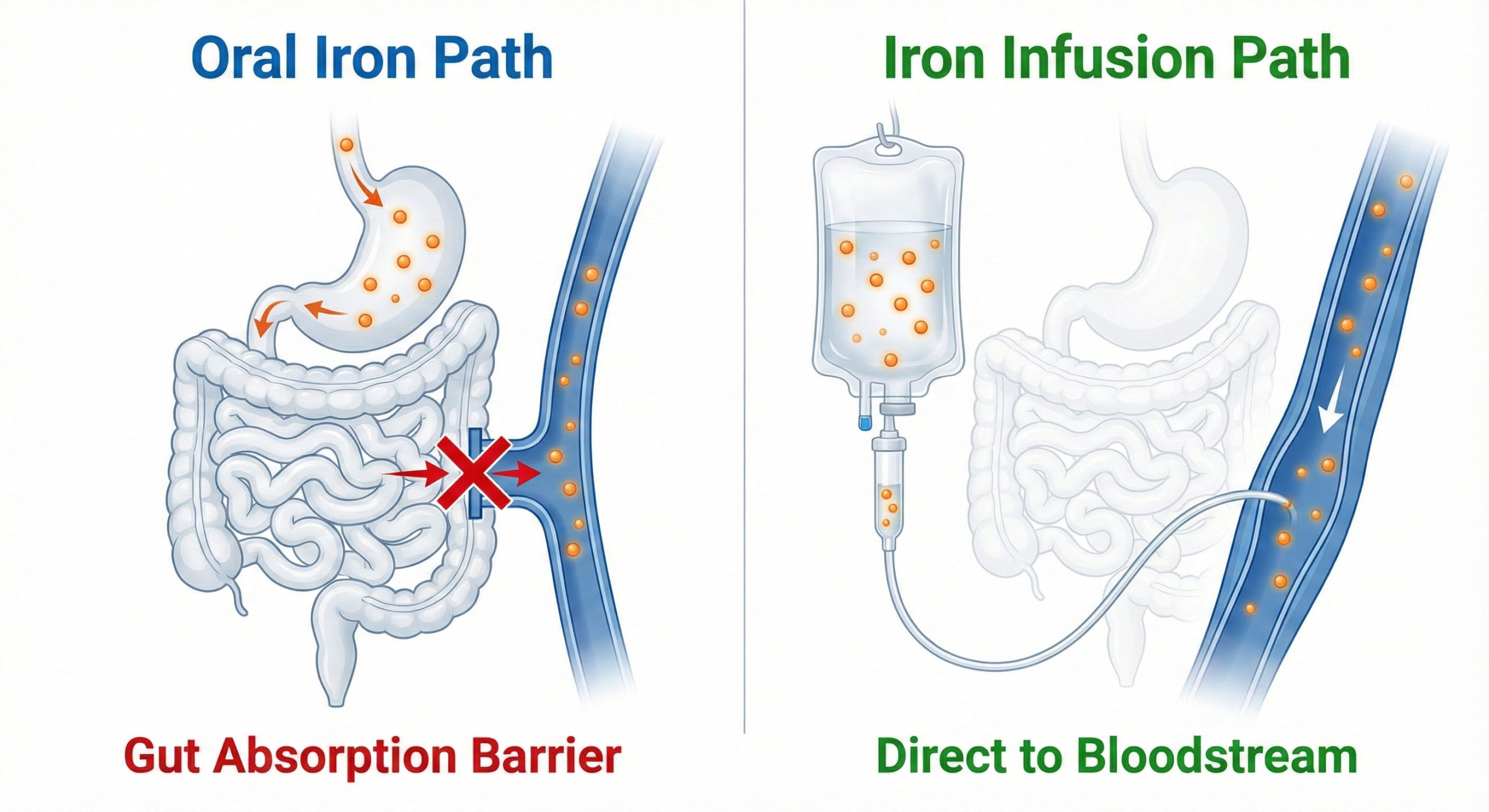Physical performance depends on far more than strength and endurance. Behind every successful training session or competition lies the body’s ability to recover, repair, and adapt. When recovery falls short, even the most consistent effort can lead to fatigue, reduced focus, and slower progress. In recent years, IV therapy has become one of several clinically supervised options that may support recovery and hydration in people with high physical demands, including athletes and active individuals.
Across Australia, particularly in Victoria, more people engaged in endurance and strength-based activities are exploring complementary medical treatments that support hydration and nutrient replenishment under clinical supervision. Intravenous vitamin and hydration therapy in Melbourne is one such option, provided in medical settings where treatment plans are developed according to each individual’s needs. This approach aims to help the body restore balance and maintain adequate hydration, especially during periods of increased physical stress.
It is important to understand that IV therapy is a medical procedure performed under professional supervision. It does not replace a balanced diet, structured training, or rest, but can play a supportive role when tailored to individual needs through proper medical assessment.
Understanding What IV Therapy Involves
IV therapy, short for intravenous therapy, involves the administration of fluids, vitamins, and minerals directly into the bloodstream through a vein. This allows for faster absorption compared to oral supplements, which must first pass through the digestive system.
In a medical setting, IV therapy is delivered using sterile equipment and under clinical supervision. Formulations are carefully prepared to suit individual health requirements and may vary depending on a person’s age, nutritional status, and medical history. Typical components include saline for hydration, along with specific vitamins or minerals that help replenish nutrients that may be depleted through regular physical activity.
In Australia, IV therapy is regulated to ensure it meets strict medical standards. It should only be carried out by qualified healthcare professionals trained in both the preparation and administration of intravenous treatments.
Why Recovery Matters for Athletic Performance
The human body relies on efficient recovery to maintain performance over time. Training creates microscopic muscle damage, temporarily depletes energy stores, and challenges the body’s hydration balance. Without proper replenishment, this can lead to lingering fatigue, increased injury risk, and slower progress.
Athletes often experience symptoms such as muscle soreness, decreased endurance, or reduced concentration when recovery is incomplete. Effective recovery helps the body restore electrolyte levels, reduce inflammation, and repair muscle fibres. While food, fluids, and rest remain the foundation of recovery, some individuals explore medical treatments like IV therapy under professional supervision to support these physiological processes.
Recovery is not just about what happens after exercise; it determines how well the body performs in the next session. Supporting recovery at the cellular level helps maintain consistency and performance over time.
How IV Therapy May Support Recovery and Performance
IV therapy can assist in restoring hydration and replenishing essential nutrients that the body may lose through intense exercise. For example, fluids help maintain blood volume and temperature regulation, while certain nutrients play roles in muscle function and energy production.
Some IV formulations used in medical settings may include B vitamins, magnesium, and vitamin C. These nutrients are involved in energy metabolism, tissue repair, and reducing oxidative stress. By replenishing these elements more directly, IV therapy can provide a faster way to restore balance when oral intake or digestion is compromised.
It’s important to note that IV therapy is not designed to enhance athletic ability directly. Instead, it may support recovery by addressing dehydration or nutrient depletion that interferes with normal muscle and nervous system function. The decision to use IV therapy should always follow a medical assessment to ensure it aligns with a person’s health status and performance goals.
The Role of IV Therapy in Managing Fatigue and Energy Levels
Persistent fatigue can affect both training quality and overall well-being. This fatigue may result from nutrient deficiencies, poor sleep, dehydration, or overtraining. Medical IV therapy offers a way to correct certain imbalances more efficiently by bypassing the digestive system.
In a supervised clinical environment, IV therapy can assist in replenishing nutrients involved in energy production, such as B vitamins and magnesium. These nutrients support enzyme activity in the body’s energy pathways and help reduce the feeling of exhaustion that sometimes follows prolonged exertion.
People in Victoria who experience ongoing tiredness related to low iron or nutrient depletion may also benefit from assessment for IV iron treatment in Melbourne, which is designed to restore iron stores under medical supervision when oral supplements are not sufficient. Such treatments should always be prescribed and monitored by a qualified healthcare professional.
IV Therapy and Hydration Balance for Endurance
Hydration is one of the most critical aspects of athletic performance. Even mild dehydration can impair muscle function, reduce endurance, and increase perceived effort during physical activity. Restoring fluids after exercise is therefore essential for recovery.
In some clinical situations, IV fluids may be used to correct dehydration more efficiently than oral fluids. This can be particularly useful when individuals experience gastrointestinal upset or cannot tolerate large amounts of water after exercise.
Maintaining proper hydration supports cardiovascular function, nutrient transport, and temperature control, all vital to athletic endurance. While IV therapy can assist in restoring hydration, it should only be considered after clinical assessment, especially for individuals training in extreme conditions or with underlying medical concerns.
The Importance of Medical Assessment and Personalised Care
No two athletes or active individuals are the same. Factors such as training intensity, diet, age, and medical history all influence recovery needs. A comprehensive medical assessment helps determine whether IV therapy is appropriate and what type of formulation is most suitable.
During an assessment, a doctor will review relevant health information, including blood tests if necessary, to identify possible deficiencies or imbalances. This process ensures that any IV therapy provided is evidence-based, targeted, and safe.
A medical practitioner will also determine whether IV therapy should form part of a broader treatment plan that may include dietary changes, supplementation, or lifestyle adjustments. This personalised approach helps achieve lasting benefits rather than short-term relief.
Functional Medicine and a Whole-Body Approach to Athletic Health
Functional medicine looks beyond isolated symptoms to explore how different systems in the body work together. For athletes, this means considering not only physical training but also nutrition, sleep, mental health, and stress management.
At Clarendon Medical, functional medicine principles guide a comprehensive approach to care. IV therapy may be integrated into a tailored health plan to address specific nutrient needs or recovery challenges, but it is always considered alongside broader lifestyle and medical factors.
Supporting long-term performance involves maintaining balance across the body’s systems. When recovery, hydration, and nutrition are aligned, athletes are better equipped to sustain their goals safely and effectively.
Safety, Clinical Standards, and Evidence-Based Practice
All medical procedures carry some level of risk, and IV therapy is no exception. Common side effects can include mild bruising or discomfort at the injection site. In rare cases, allergic reactions or vein irritation may occur. This is why IV therapy should only be performed by trained medical professionals using sterile, high-quality, TGA-approved solutions.
Clinics offering IV therapy in Australia must adhere to strict infection control and procedural safety standards. Patients are monitored throughout treatment to ensure comfort and safety.
Evidence-based practice means every aspect of IV therapy, from formulation to administration, is supported by scientific understanding and professional judgement. The focus remains on achieving safe, medically appropriate outcomes rather than cosmetic or non-medical goals.
FAQs
Q1: What is IV therapy, and how does it differ from oral supplements?
A1: IV therapy delivers fluids and nutrients directly into the bloodstream, bypassing the digestive system. This allows for faster absorption than oral supplements, which must be broken down and absorbed through the gut.
Q2: Is IV therapy suitable for all athletes?
A2: Not necessarily. A medical assessment is essential to determine whether IV therapy is appropriate based on individual health, training demands, and nutritional status.
Q3: How long does an IV therapy session take?
A3: A typical IV therapy session lasts between 30 and 60 minutes, depending on the formulation and clinical setting.
Q4: Are there risks or side effects?
A4: Side effects are usually mild but can include bruising, vein irritation, or slight discomfort. All procedures should be conducted by trained professionals to ensure safety.
Q5: How often can IV therapy be safely administered?
A5: Frequency depends on an individual’s needs and the recommendation of a healthcare professional. Overuse without a medical indication is not advised.
Disclaimer
This content is for informational purposes only and is not a substitute for medical advice. Always consult a qualified healthcare professional before undergoing any treatment, including IV therapy.



